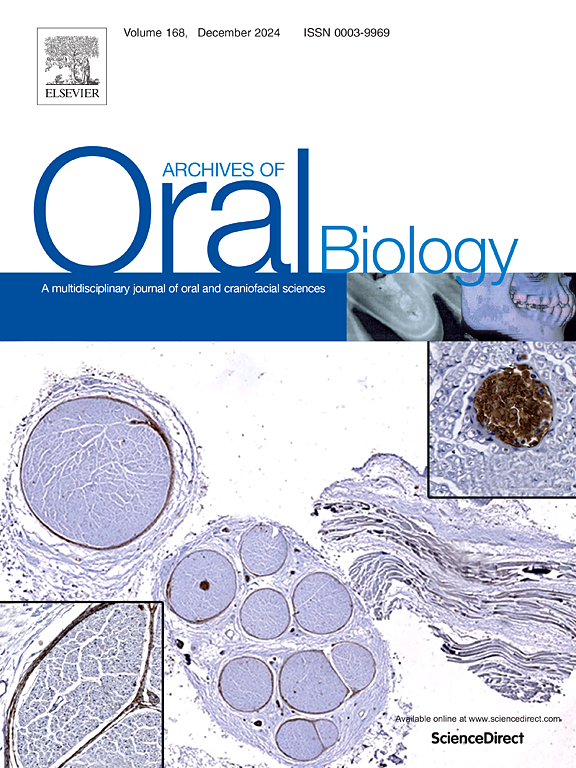Effects of Porphyromonas gingivalis lipopolysaccharide on the behavior of human dental pulp stem cells in vitro and their inflammation-related transcriptomics profile
IF 2.1
4区 医学
Q2 DENTISTRY, ORAL SURGERY & MEDICINE
引用次数: 0
Abstract
Objective
The inflammatory microenvironment in pulpitis and periapical periodontitis critically impairs dental pulp stem cells (DPSCs) functionality, yet the underlying molecular mechanisms remain poorly defined. This study aimed to investigate the effects of Porphyromonas gingivalis lipopolysaccharide (P. gingivalis LPS) on human DPSCs behavior and elucidate the transcriptomic changes underlying LPS-induced inflammation.
Design
Human DPSCs were exposed to 1 µg/mL LPS for 24 hours to establish an inflammatory model, with subsequent evaluation of proliferation (CCK-8), migration (Transwell), and odontogenic differentiation (ALP staining, mineralization assays and odontoblast markers expression). Cell cycle progression was quantified through flow cytometry, while RNA sequencing analysis delineated transcriptional alterations.
Results
LPS exposure significantly attenuated DPSCs proliferative capacity (P < 0.01), suppressed migration (P < 0.01), and impaired odontogenic differentiation, evidenced by diminished ALP activity, mineralized nodule formation and odontoblast markers expression. Cell cycle analysis revealed G0/G1 phase arrest (P < 0.01), indicating proliferative quiescence. Transcriptomic profiling identified 467 differentially expressed genes. P. gingivalis LPS exerts its effects on DPSCs by concurrent activation of both canonical (Toll-like receptors, TLRs) and non-canonical (Nucleotide-binding oligomerization domain-like receptor) signaling pathway. Pathway enrichment revealed the enrichment of the several important signaling pathways such as Phosphatidylinositol 3 kinase-protein kinase B (PI3K-Akt), tumor necrosis factor (TNF) /Nuclear factor kappa B (NF-κB) and interleukin (IL) −17 signaling under LPS stimulation.
Conclusion
P. gingivalis LPS disrupts DPSCs regenerative functions by modulating inflammatory and developmental signaling pathways, providing mechanistic insights into impaired pulp repair during oral infections.
牙龈卟啉单胞菌脂多糖对体外培养人牙髓干细胞行为及其炎症相关转录组学的影响
目的牙髓炎和根尖周炎的炎症微环境严重损害牙髓干细胞(DPSCs)的功能,但其潜在的分子机制尚不清楚。本研究旨在探讨牙龈卟啉单胞菌脂多糖(P. gingivalis LPS)对人DPSCs行为的影响,并阐明LPS诱导炎症的转录组学变化。将人DPSCs暴露于1 µg/mL LPS中24 小时,建立炎症模型,随后评估增殖(CCK-8)、迁移(Transwell)和成牙分化(ALP染色、矿化测定和成牙细胞标志物表达)。通过流式细胞术量化细胞周期进程,而RNA测序分析描绘了转录变化。结果slps暴露显著降低了DPSCs的增殖能力(P <; 0.01),抑制了迁移(P <; 0.01),并损害了牙源性分化,表现为ALP活性降低、矿化结节形成和成牙细胞标志物表达。细胞周期分析显示G0/G1期阻滞(P <; 0.01),表明增殖静止。转录组学分析鉴定出467个差异表达基因。牙龈卟啉卟啉脂多糖通过同时激活典型(toll样受体,tlr)和非典型(核苷酸结合寡聚化结构域样受体)信号通路对DPSCs产生影响。通路富集揭示了磷脂酰肌醇3激酶-蛋白激酶B (PI3K-Akt)、肿瘤坏死因子(TNF) /核因子κB (NF-κB)和白细胞介素(IL) - 17等重要信号通路在LPS刺激下的富集。LPS通过调节炎症和发育信号通路破坏DPSCs的再生功能,为口腔感染期间受损的牙髓修复提供了机制见解。
本文章由计算机程序翻译,如有差异,请以英文原文为准。
求助全文
约1分钟内获得全文
求助全文
来源期刊

Archives of oral biology
医学-牙科与口腔外科
CiteScore
5.10
自引率
3.30%
发文量
177
审稿时长
26 days
期刊介绍:
Archives of Oral Biology is an international journal which aims to publish papers of the highest scientific quality in the oral and craniofacial sciences. The journal is particularly interested in research which advances knowledge in the mechanisms of craniofacial development and disease, including:
Cell and molecular biology
Molecular genetics
Immunology
Pathogenesis
Cellular microbiology
Embryology
Syndromology
Forensic dentistry
 求助内容:
求助内容: 应助结果提醒方式:
应助结果提醒方式:


